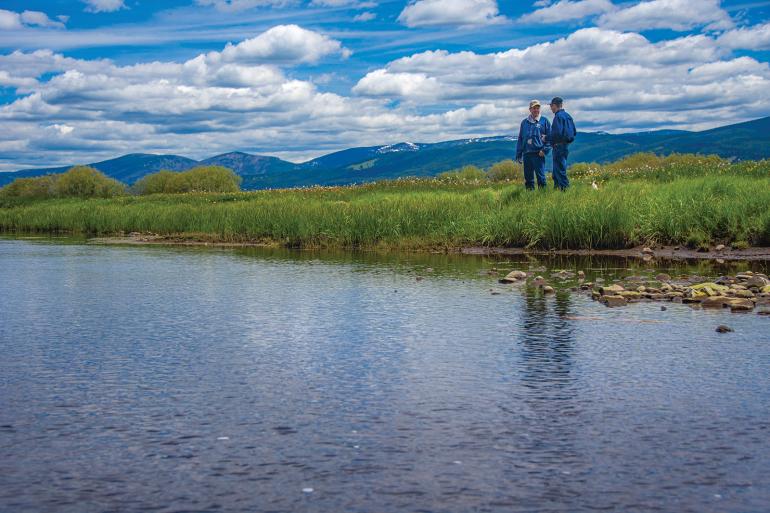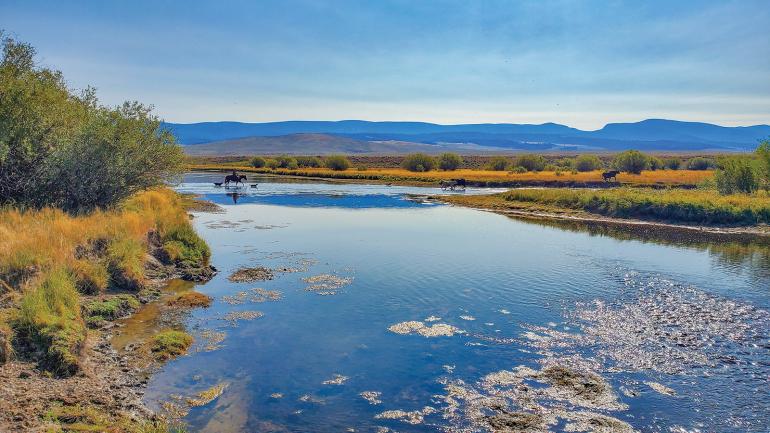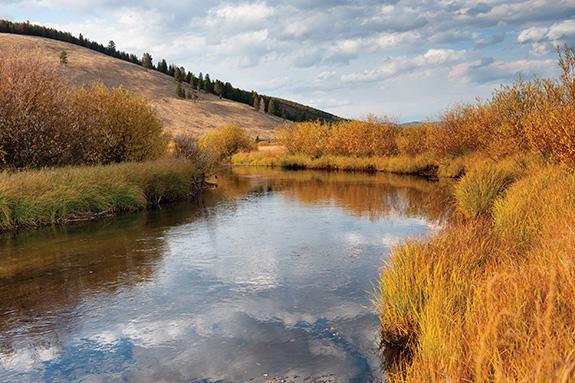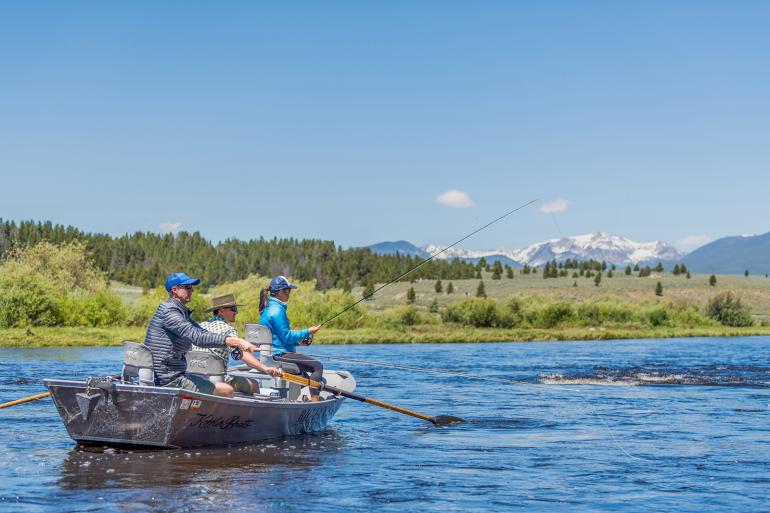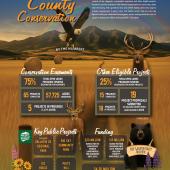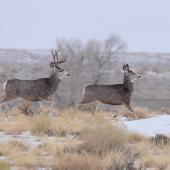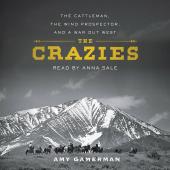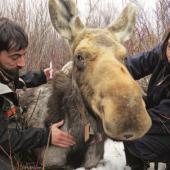Reel Concerns for the Big Hole
What the future holds for Montana's most iconic river.
Montana’s Big Hole River has been considered one of the Treasure State’s gems by anglers for nearly 150 years. It gained attention in the late 1800s when the eastern fishing journal, The Angler’s Guide, advertised the Big Hole as a national destination for fishing.
Around the same time that The Angler’s Guide was telling people out East about the exceptional fishing in the river, homesteaders in the West were discovering the fertile land in the valley. A number of those homesteaders established ranches along the Big Hole, some of which are still operated by the very families that started them toward the end of the 19th century.
The importance of those tourist dollars to the Big Hole valley’s economy can’t be overstated. And those dollars dry up when the river shuts down.
Springing from Skinner Lake in the Beaverhead Mountains of the Bitterroot Range, the Big Hole sets a 150-mile course towards the Beaverhead, where the two rivers merge and form the Jefferson. Today, ranchers and anglers alike use the Big Hole as a means of generating income—one tapping it as a resource to water crops and feed livestock, the other utilizing it as habitat from which to pull fish and tourist dollars. Known for its outstanding trout fishing, and the last place outside of Alaska where fluvial Arctic grayling can be found, in recent years the Big Hole has been beleaguered by fishing restrictions and closures.
Though water is a renewable resource, it’s finite, and can’t be replenished indefinitely. Only about three percent of Earth’s water is freshwater, and local water supplies can easily be lost through contamination, overuse, and drought. 2024 saw Montana in its fourth consecutive year where portions of the state were experiencing moderate to severe drought conditions, and it remains to be seen how future years will fare. Needless to say, the Big Hole hasn’t been immune to the drier environment.
Consequently, Montana Fish, Wildlife & Parks (FWP) has a conservation strategy to deal with years when water is at a premium: the Montana Drought-Management Plan. The program starts by breaking the Big Hole into six different sections, each section having a set of flow triggers. Those triggers are set off when the flow rate gets too low, and encourages ranchers to voluntarily start conserving water. But, if water levels continue to drop, and they reach the lowest criteria determined by FWP, the agency will shut down fishing on the river.
When water gets low in the Big Hole, ranchers are asked to voluntarily reduce their consumption, whereas outfitters are mandated to stop fishing.
Along with closing the river due to low flows, FWP will also institute “hoot-owl” restrictions. These are implemented based upon water temperature. If temps remain at or above 73 degrees for more than three days in a row, then FWP will shut down angling from 2pm to midnight.
Fish biologist Jim Olson, a 23-year veteran of FWP, with 17 of those years spent on the Big Hole, explains, “The plan relies on voluntary reductions of water use by ranchers, and is built on the model of shared sacrifice. If we’re asking ranchers to give up water to keep it in the river, we should be asking fisherman to sacrifice something as well. That’s why there are angling closures associated with those flow triggers—to relieve any stress on fish that are already strained due to low flows and high temps.”
But some don’t see that sacrifice as being equal.
Shaun Jeszenka owns and operates the Frontier Anglers fly shop in Dillon. Originally from Missoula, he’s been guiding and outfitting in southwest Montana for over 30 years. He’s one of several outfitters who depend on the Big Hole to maintain a profitable business, and when FWP closes down the river to fishing, he sees and feels the financial repercussions it has on the local community.
Ranchers and anglers alike use the Big Hole as a means of generating income—one tapping it as a resource to water crops and feed livestock, the other utilizing it as habitat from which to pull fish and tourist dollars.
In 2023, the Institute for Tourism and Recreation Research reported that out-of-staters brought in $5.45 billion to Montana, directly supporting gas stations, restaurants, retail stores, state parks, and outfitters, among others. Those dollars sustain 67,000 jobs—meaning 1 in 12 Montana workers is supported by out-of-state money.
The importance of those tourist dollars to the Big Hole valley’s economy can’t be overstated. As Jeszenka says, “A lot of the tourists that come in are high-dollar fishermen. When they spend a dollar with me, or they stay at a hotel, or they go to a restaurant, that dollar bounces around the local economy.” And those dollars dry up when the river shuts down.
2024 saw Montana in its fourth consecutive year where portions of the state were experiencing moderate to severe drought conditions, and it remains to be seen how future years will fare.
Jeszenka notes several factors that have led to closures, one of them being the apparent change in climate. “Our fall temperatures are now staying in the 70s. It used to be if there were closures or hoot-owl restrictions, you’d get some kind of moisture and it would cool down. But now we’ve seen situations three of the last four years where once they close it, there’s a good chance it’s not going to open up again that year. If you told me that ten years ago, I would’ve told you that’s not possible.”
In addition to the recent changes in the weather, Jeszenka also mentions the ramification that irrigation has on water levels. Many of the ranchers along the Big Hole have water rights that allow them to pull water from the river to irrigate their land. But when water gets low on the river, as FWP explains, ranchers are asked to voluntarily reduce their consumption, whereas outfitters are mandated to stop fishing. Jeszenka says, “If you have stretches of one of the best freestone trout rivers in the northern Rockies that are only open for four months out of the year because they’re so heavily dewatered, then in my opinion, it indicates a watershed that is out of balance.”
"Once FWP closes the river, there’s a good chance they're not going to open up again that year."
— Steve Jeszenka
While Jeszenka recognizes that ranchers have a legal right to use the Big Hole in order to secure a living, he sees one side—his—bearing the brunt of the burden. “Cattle prices are high, and the ranchers are doing well. But we’re forced to stop fishing all the time. If we continue along this slope that we’re on, or if it gets worse, we might start losing people in my industry.”
Regardless of where one falls on the issue of water use on the Big Hole, management of it as a resource needs to be an ongoing topic of conversation, with considerable effort expended to try and solve the problem. Because as Jeszenka reminds us, “Water is the lifeblood of any river.”
Two Groups, One Goal
by Dave Hemphill
Dedicated to conserving and defending the river since 1988, the Big Hole River Foundation (BHRF) was founded by distinguished conservationist and angler George Grant. The foundation works to keep the Big Hole a viable resource through careful water-quality monitoring. Brian Wheeler is the organization’s executive director; as a whitewater and fishing guide for 20 years, he understands the value of the Big Hole as the economic catalyst behind ranching and recreation, and that water quality on the river is vital to both those endeavors. In part due to BHRF’s efforts, the Big Hole remains un-dammed, streambank development is limited, recreationists enjoy ample access, and communities tied to the river continue to do well. To learn more or get involved, visit bhrf.org.
Started in 1995, the Big Hole Watershed Committee (BHWC) is committed to the protection of the entire watershed. Their comprehensive approach includes safeguarding floodplains, communities, wildlife, water, and the fisheries throughout the valley. Executive director Pedro Marques joined BHWC in 2016; an eclectic group comprises their governing board, with interests that include ranching, utilities, local government, sportsmen, conservation, tourism, and outfitting. In 1997, BHWC published the state’s first Drought Management Plan, and since the organization’s formation, no stretch of the Big Hole has run dry. In addition, the grayling population in the river has improved under BHWC’s stewardship. To learn more, visit bhwc.org.
This piece originally appeared in the Spring/Summer digital edition of Montana Fly Fishing Magazine. You can check out the article here.


